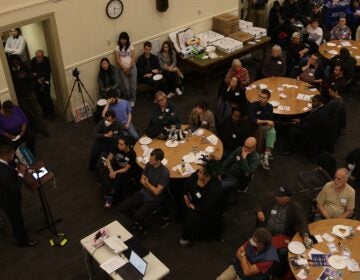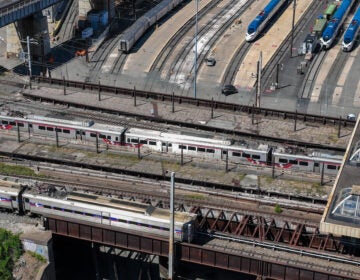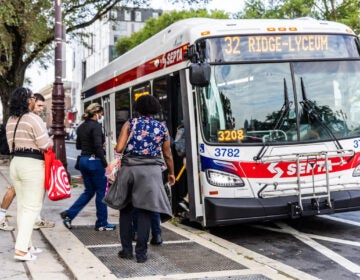Rina Cutler aims to keep it real

Oct. 25
By Anthony Campisi
For PlanPhilly
Rina Cutler plays a unique role among the region’s government decision makers.
As deputy mayor for transportation and utilities, she directs the two of the city’s most vital planning functions but has little direct control over SEPTA or the Delaware River Port Authority, the region’s two main transit operators. And she must work with state government agencies, like the Pennsylvania Department of Transportation, local organizations like the Delaware River Waterfront Corp. and her counterparts in the surrounding counties to accomplish much of her agenda.
Yet unlike many in Mayor Michael Nutter’s cabinet, Cutler has extensive experience in the region, which she says has helped her develop the types of relationships crucial to getting her job done.
Before coming to city government, Cutler worked at PennDOT, where she served as deputy secretary for administration and as acting district executive for Southeastern Pennsylvania. This has put her in the position of managing the same infrastructure projects on both the city and state level — though, she deadpans, “I had a lot more money” at PennDOT.
Lessons in the South Street Bridge saga
The most public example of this has been in construction of the new South Street Bridge.
Though Cutler tried to move the project forward after years of delays while at PennDOT, as deputy mayor, she played a crucial role in rethinking the design after complaints from neighborhood groups surfaced that the new bridge wasn’t sensitive to the communities it would connect.
Though Cutler expects the project to be completed on time and on budget by next fall, she said that the experience has taught her the importance of continuing to communicate with neighborhood groups throughout the course of a long project.
The first South Street Bridge design came out of an extensive public process, she said. The problem was that the design sat on a shelf for 15 years before construction actually began. In the intervening years, Graduate Hospital, the neighborhood east of the Schuylkill the bridge serves, gentrified.
Many in the community whom PennDOT and the city first contacted while drawing up plans for the bridge no longer lived in the neighborhood by the time construction actually began, Cutler said.
Life through wide range viewfinder
At the same time, Cutler’s new position affords her a new breadth and depth in infrastructure planning. She’s in charge of a portfolio ranging from public transit to stormwater management to the Philadelphia Airport. At the same time as she deals with the immediate issues confronting Philadelphia infrastructure, she also wants to envision what the city will look like 30 years down the road.
“Philly’s got great bones,” she says. The problem is figuring out how to make use of them.
Take the Philadelphia Airport. Though 32 million people pass through it annually, it has long been known as one of the most inhospitable major airports in the country.
Cutler has sought to burnish the airport’s image through customer-service changes, by focusing on improved and concentrated relationships with the airport’s major carriers to make logistical improvements to passenger transfer, check in and baggage handling.
She sees a day when a new combined AMTRAK stop and bus depot connects the airport to the Northeast Corridor transportation system, creating an intermodal, international transit hub for the region.
Cutler says that her job has been made easier by the Obama administration, which is pushing federal policy toward concepts like transit-oriented development and contact-sensitive design — a priority for Cutler.
Planners and transit officials at the state level and in major cities are now sharing a “common language” with their federal counterparts, she said.
Try something bold
“Let’s not waste this opportunity,” Cutler said, adding that she is taking advantage of changes at the federal level to experiment.
The most visible sign of this so far has been the two bike lanes Cutler championed along Spruce and Pine streets.
When the administration first floated the idea of closing a lane of traffic to cars, many living along those streets were adamantly opposed.
“People were aghast, as if we were truly stealing their firstborn child,” Cutler said, adding that she and her staff had to explain that fast traffic isn’t necessarily a good thing for a residential neighborhood. Bike lanes might slow down traffic, but slower cars translate into greater pedestrian safety.
Cutler has received hundreds of letters and emails about the lanes and estimates that about 60 percent of responses have been favorable.
And based on anecdotal evidence — the one or two times she drives every week, she makes it a point to head down Spruce or Pine — Cutler thinks that cars have been respecting the lanes.
Here comes a new initiative
Cutler and SEPTA also had their first meeting in September for the new Transit First committee, which will be looking at improving transit service along selected commercial corridors. As previously reported (http://www.planphilly.com/node/9666), the committee will look at speeding bus and trolley times.
Cutler said that the committee is currently gathering data to decide the corridors on which it will focus and will release the results after the selections have been made,
Further into the future, Cutler says she sees a day when regional funding sources cover costs to fund service and system expansion.
Though she is lobbying Harrisburg to keep Act 44 funding in place, she said that a regional funding mechanism is “the best option” for maintaining SEPTA and further expanding the system in the long term.
“There is agreement [in Southeastern Pennsylvania] that transit needs a funding source,” she said, though discussions about greater county contributions or a regional tax are just beginning.
She envisions a construct in which the five counties of Southeastern Pennsylvania would opt into a new funding mechanism, which would be designed to keep investment dollars among participants. Cutler doesn’t want a recalcitrant suburban county to reap the benefits of Philadelphia investments if it’s also not willing to shoulder the costs.
Make Philly first again
Cutler acknowledges that restoring Philadelphia’s place as the region’s economic and population center would go a long way toward creating the buy-in needed to support the current Philadelphia-centric transit system. Though she supports transit-oriented development as a way of making the city more attractive to prospective residents and businesses, she said that most of the responsibility for pushing that agenda lies in the Philadelphia Planning Commission.
As for the Delaware River Port Authority’s proposed light rail line along Delaware Avenue, she says it has the potential to be a “game changer for the city” as the only planned service expansion in Philadelphia.
Cutler pushed hard to bring the proposed line into Center City, arguing that the first proposals isolated the line from the city’s existing transportation network and from potential riders.
She argues that the line — which will probably run along Market Street from City Hall — won’t take passengers away from the Market-Frankford El and offers the city a chance to reroute buses off Market Street and onto side streets and into a new bus terminal she’s thinking about to replace the current Greyhound station on North 11th Street.
But because the line is about a decade away, Cutler says public transit won’t have an impact on expected traffic at the proposed casino sites along the Delaware River.
Though she’s less concerned with the Sugarhouse site, she said that both casinos have an interest in addressing traffic concerns to draw in potential customers. Though Cutler said that the big box stores along the river, like IKEA, generate more traffic than the casinos will, she is meeting with PennDOT to try to mitigate congestion. In any case, she argues, congestion along Columbus Boulevard and Delaware Avenue might make the streets safer for pedestrians.
Water issues everywhere
Yet out of all the responsibilities in her portfolio, Cutler says that the hardest infrastructure challenge she faces is dealing with the city’s antiquated sewage and water systems.
Water quality is an inherently regional problem — “rivers have no county lines,” she notes — but it lacks the kind of clear constituency that something like a train line gets from its riders.
Though Cutler spends much of her time envisioning Philadelphia’s future, she is a hard-headed realist about what she can expect to accomplish.
“I am not … anti-car,” she said, adding that it will be Americans’ main mode of transportation for decades.
“Part of my role is to rein in some of the blue-sky vision things,” Cutler explained, referring to her work at the Delaware River Waterfront Corp., the successor to the Penn’s Landing Corp. charged with developing a master plan for the riverfront.
She says that soliciting public input — which PennPraxis did when developing the Civic Vision for the waterfront — is different from implementing a development plan.
Cutler speculates that her realization of that distinction — and her willingness to shoot down ideas that she doesn’t think can actually be realized — is probably why Nutter appointed her to the board.
Contact the reporter at campisi.anthony@gmail.com
WHYY is your source for fact-based, in-depth journalism and information. As a nonprofit organization, we rely on financial support from readers like you. Please give today.






